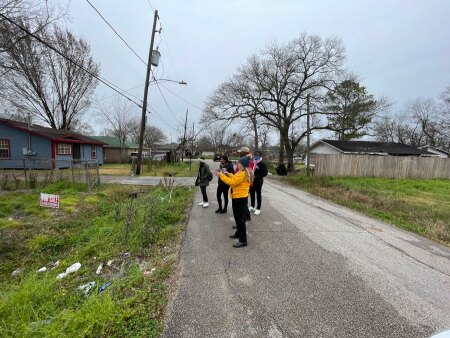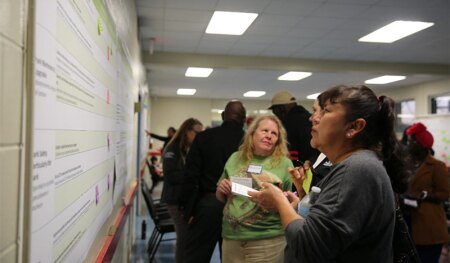Settegast, a neighborhood in Northeast Houston, is home to a resilient and tight-knit community that has mobilized in response to decades of discriminatory practices and under-resourcing. As a result of systematic neglect, Settegast residents face challenges such as displacement, gentrification, and most notably, poorer health outcomes, including the lowest life expectancy rate in Harris County. These conditions reflect struggles faced by Black Houstonians and marginalized communities across the United States.
To find solutions, ULI Houston partnered with Harris County Public Health, the Houston Land Bank, the Kinder Institute for Urban Research, and convened community residents and real estate leaders to build trust and chart a more equitable future for the neighborhood.
The efforts of ULI Houston have led to:Enhanced dialogue and collaboration between neighborhood residents, government agencies, community groups, and other stakeholders.
- Leveraging data and community perspectives to shape ongoing community planning, development, and research initiatives.
- Securing a commitment from Harris County Public Health’s Built Environment Unit to develop a Community Action Plan for Settegast, with input from residents, who will stay involved through its implementation.
On the Front Lines of Change
Just northeast of Downtown Houston, residents of the historically Black yet increasingly Latinx Settegast community find themselves on the frontlines of change. While some households are faring better than others, there are challenges for people who live in Settegast, including a combination of speculative development, locally unwanted land uses, and more frequent flooding due to climate change. Despite the odds, this resilient community is pushing the boundaries to build a brighter, healthier future together.
The story of Settegast reflects the history of Black communities in Houston and similar neighborhoods across the United States. In the 1920s, discriminatory policies known as redlining and restrictive covenants limited access to home ownership and renting. In Houston, Black families were forced to settle beyond the city limits in rural areas like Settegast, which were provided with minimum infrastructure and limited access to services.
Over time, the combination of sustained racism and systemic neglect at the hands of municipal, real estate, and financial leaders led to the decline of the community, with the population decreasing from 4,352 in the year 2000 to 3,255 in 2019.
Today, residents, government, local organizations, and real estate leaders have joined forces to understand the story of Settegast and confront the growing list of neighborhood threats, including a wave of low-quality speculative development, displacement of longtime residents, unmitigated flooding, and the impact of locally unwanted land uses such as adjacent landfills and a growing number of intermodal freight facilities.
A Challenging History
In the 1920s, discriminatory practices locked Black families out of Houston’s housing market, leading them to settle in Settegast, an unincorporated area on the city’s northern fringe. Despite annexation by Houston in 1949, neglect from local government persisted. The community received little investment in infrastructure such as roads and drainage.
“Residents were taken advantage of by lenders,” says Elizabeth Van Horn, an urban planner and public health analyst at Harris County Public Health. “Homes were purchased predominantly by contracts for deeds with extremely high-interest rates and payment schedules structured in such a way that residents barely made a dent into paying down the actual cost of the home. Furthermore, homeowners were not given their deed until they actually paid off the home, which was nearly impossible for these middle-class working families.”
The publication of The Settegast Report by the Houston-Harris County Economic Opportunity Organization (H-HCEOO) in 1966 aimed to address these issues but failed to reverse the cycle of disinvestment. As Jim Crow laws were dismantled, residents sought better opportunities elsewhere, resulting in a decline in population. Because it did not have zoning regulations, Settegast was vulnerable to undesirable developments like landfills and an expansive rail yard, which caused detrimental effects on residents’ health, well-being, sense of community, and property values.
Enduring Impacts
As a result of these forces, Settegast suffers from severe health disparities, with the lowest life expectancy in Harris County and high rates of asthma, chronic obstructive pulmonary disease COPD, high blood pressure, obesity, and diabetes. These health outcomes are intertwined with socioeconomic factors, as historical disinvestment has limited wealth-building opportunities and higher-paying jobs.
Settegast has a poverty rate of 39 percent, in contrast to the newer, more affluent Clear Lake neighborhood, a Houston suburb, which has the longest life expectancy in Harris County and a poverty rate of 1.5 percent. Settegast residents grapple with limited access to healthcare, healthy food, and inadequate infrastructure, while increasing environmental hazards pose ongoing threats.
Overcoming these systemic inequities necessitates intentional investments in infrastructure, services, and resources. Addressing historical injustices and pursuing equitable development is paramount in breaking the cycle of disinvestment and enhancing the lives of marginalized residents.
“The neighborhood needs attention. We are underresourced and underdeveloped. Beyond residents, there’s a complete lack of attention. Non-residents just don’t care about our neighborhood. But the historic voices, the African American voices have been beating the drum for so long,” says Kyle Maronie, a longtime Settegast resident and a project team member. “We love Settegast. I love Settegast.”
“It’s [also] close to extremely biodiverse natural land in Harris County where two major rivers come together,” says team member Carolyn White. “It has quite a bit of potential for environmental planning around the natural land preservation and biodiversity.”
A Partnership for Health Equity
As part of the ULI Partnership for Health Equity program, ULI Houston’s project team—including Elizabeth Van Horn, Parul Pillai, Carolyn White, and Kyle Maronie at Harris County Public Health, and David Kim and Misty Loocke at ULI Houston—convened stakeholders to discuss future opportunities for equitable change in the Settegast community that may include real estate and community development and infrastructure investment. Over the past year and a half, the group conducted extensive historical research, engaged with residents and local organizations, and facilitated collaboration with ULI members, developers, and local government.
To understand the forces that have shaped the neighborhood, the team delved into the discriminatory policies and practices that impacted Settegast and Houston, utilizing resources like the Houston History Research Center and the African American History Research Center. Quantitative and qualitative data collection and analysis were also employed, with the Kinder Institute playing a crucial role in analyzing quantitative data and facilitating community data workshops.
Infrastructure assessments were conducted to capture the condition of Settegast’s infrastructure. The team utilized the Harris County Public Health Department’s Infrastructure Assessment Tool to research residents’ concerns. The assessment revealed issues such as missing or inadequate infrastructure, including sidewalks, drainage systems, and road conditions.
Bilingual community engagement played a vital role in the project, including one-on-one listening sessions, focus groups, workshops, and door-knocking. Local community ambassadors and a language justice and translation consultant were involved and compensated to ensure inclusivity and to build trust. A leadership committee consisting of diverse partners provided feedback and guidance throughout the project.
Practitioner engagement included focus groups and conversations with local developers and government representatives. These discussions revolved around affordability, health equity, racial equity, and innovative development ideas to meet residents’ needs.
The engagement process shed light on Settegast’s assets, concerns, needs, and aspirations, which informed the development of an action agenda. The project team also explored existing policies, programs, and tools that could benefit the community while identifying regional policy shortcomings for further examination.
An Action Agenda for Change
The Action Agenda for Change—a collaborative effort between Settegast residents, Harris County Public Health, the Kinder Institute for Urban Research, the Houston Land Bank, and ULI—offers a roadmap to start to rectify historical inequities and advance health and racial equity. The Action Agenda proposes specific actions to drive internal real estate practice changes, expand opportunities for community engagement, and advocate for policy adjustments. The agenda includes recommendations for ULI Houston, the local real estate development community, and local policymakers that would ultimately lead to healthier, equitable community development in Harris County.
Recognizing that the real estate community is an essential part of equitable change in Settegast, the plan calls for ULI Houston to establish a committee focused on health and racial equity, recruit members from historically excluded demographic groups, and support educational initiatives in underserved communities. The agenda also emphasizes, for the real estate industry as a whole, the importance of community involvement, suggesting the hiring of local liaisons and compensation for residents for their time and input.
Moreover, the agenda calls for policy changes on the part of the city to empower resident developers, enhance funding for infrastructure projects, and prioritize community engagement in the development process. By activating vacant lots for community benefit and establishing best practices, Settegast and other neighborhoods can regain control of their own revitalization.
In addition to the ULI Action Agenda to shape real estate practice and policies, the partnership between ULI Houston, Harris County Public Health, and Settegast residents created an implementable local Community Action Plan designed to guide community leaders in shaping a more equitable future for the neighborhood.
Together, this set of deliverables seeks to address the challenges faced by both at-large Houston and the Settegast neighborhood. By implementing these strategies, ULI Houston aims to promote equity, meet community needs, and drive positive change within the real estate industry.
“We’re also producing a more robust Action Plan for the neighborhood beyond what we’ve produced for ULI so that we can more fully address all the needs that we heard from residents,” says Van Horn. “We want to empower the community with the tools and information that allows them to take action and advocate for their community.”
Editor’s Note: ULI Houston is one of five district councils participating in ULI’s District Council Partnerships for Health and Racial Equity Project led by ULI’s Building Healthy Places program with support from the Robert Wood Johnson Foundation. Working over 18 months, each council, in partnership with local stakeholders and real estate leaders, crafted strategies to address legacy impacts of systemic discrimination in land use and real estate. Learn more about the collective story of impact at uli.org/partnerships.








